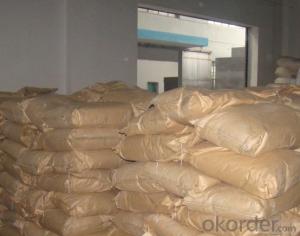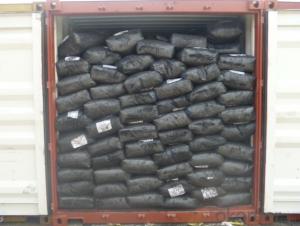Rubber Chemcials Rubber Antioxidant NDBC (NBC)
- Loading Port:
- Tianjin
- Payment Terms:
- TT OR LC
- Min Order Qty:
- 25 m.t.
- Supply Capability:
- 12000 m.t./month
OKorder Service Pledge
OKorder Financial Service
You Might Also Like
NDBC (NBC)
Chemical Name:Nickel Dibutyl Dithiocarbamate
Molecular Formula:C 18 H36 N 2 S 4 Ni
Molecular Weight:467
CAS No.:13927-77-0
Specifications:
Item
| Specifications
|
Appearance
| Dark-green Power (Granules)
|
Initial Melting Point, °C Min.
| 83
|
Heat Loss , % Max.
| 0.5 |
Nickel content , %
| 12.0 - 13.0
|
Residue on 150 µm Sieve , % Max.
| 0.10 |
Residue on 63 µm Sieve , % Max.
| 0.50 |
Properties: Dark-green Power. Density is 1.26g/ cm3 . flashing point is 260°C. Soluble in chloroform, benzene and carbon bisulfide , a little soluble in acetone, insoluble in water.
Applications: Mainly use in styrene- butadience rubber, chloroprene rubber and chlorosul-fonated polyethylene rubber. Avoiding the rubber crack for the sunshine and ozone, promoting the heat-resistant of chloroprene rubber and chlorosul-fonated polyethylene rubber. In plastic industry, it can be used as stabilitant and ozone-resistant agent for high polymer materials. It has advantage of stability for polypropylene fibre , thin film and narrow belt, but it will make the products appear yellow-green color. The use level is 0.3~0.5%. NDBC is regulated for use in articles in contact with food as specified.
Packing:Coextruded paper bags lined with polyethylene film bags. Net weight 25 kg per bag.
Storage:Store closed containers in a cool, dry, well-ventilated area. Avoid exposure to direct sunlight.
- Q: Hydrogen and oxygen in the role of the catalyst can do the chemical formula of aviation fuel?
- 2H2 + O2 = catalyst = 2H2O
- Q: What is a catalyst and how does it make a reaction go faster?
- Wohoo i stil remember this from last year! A catalyst is a substance that speeds up the chemical reaction without being used up in the reaction itself e.g. manganese dioxide in the making of oxygen. And.. A catalyst works by providing a convenient surface for the reaction to occur. The reacting particles gather on the catalyst surface and 1) collide more frequently with each other 2) more of the collisions result in a reaction between particles because the catalyst can lower the activation energy for the reaction. A catalyst is often used as a powder, so that it has a bigger surface area per gram. Okay i copied the last bit from my science book but i remembered the first bit!! HA!
- Q: why is palladium/platinum a good catalyst?
- Sparky 22 is wrong. Metals like palladium and platinum and nickel do absorb hydrogen. For example many times when doing a catalytic hydrogenation with Raney-Nickel you do not need to add H2 because enough H2 is already absorbed on the metal.
- Q: What is a catalyst in a chemical reaction?
- I didn't actually need to know what a catalyst was for my chemistry exam just what it does. A catalyst is something that speeds up a chemical reaction.
- Q: What is the maximum impact of the chemical reaction rate? Such as catalyst, temperature, concentration. If you can, you can row order.
- The catalyst certainly affects the most
- Q: I dont know what it is but when i open up my computer it comes up and it says that its not working? so i really dont know what to do.
- ATI Catalyst Control Centre is a control program for ATI graphics cards. If you have an ATI graphics card, go to the ATI website and download and reinstall the program.
- Q: Could God be Discribed as a Catalyst?
- it is my understanding that a Catalyst will bring something together that is already created. God on the other hand, according to Judeo-Christian Theology, he didn't just bring it together, he created it. plus, if the Judeo-Christian God did exist, we would have to assume (because of archaeological and scientific evidence) that He is the God of the Bible and that he does play a role in the same of things.
- Q: What suitable catalysts can I use for the reaction between Hydrochloric acid and zinc metal?
- catalysts are substances that alter the rate of a reaction.a suitable catalyst would be finely divided platinum.
- Q: What kind of chemical substances can seriously damage the ozone layer, as a catalyst or reactants can be?
- Freon decomposition of free radicals. The destruction of our ozone is mainly caused by him. Chlorine free radicals are also available.
- Q: How to poison the catalyst. What can be done?
- In the reactants or catalyst mixed with a small amount of material, so that the catalyst catalytic capacity of a sharp decline or even loss, this phenomenon is called catalyst poisoning. For example, in the synthesis of ammonia feed gas containing CO, CO2 and H2S, PH3, water vapor and other impurities, can make iron catalyst poisoning; contact with the system of sulfuric acid, if arsenic and selenium oxide (As2O3, SeO2), can make vanadium catalyst Loss of activity. Therefore, it is necessary to purify the feed gas, prevent the poisoning of the catalyst, and also reduce the corrosion of the equipment. The phenomenon of catalyst poisoning is sometimes temporary, the removal of toxicants, the effectiveness of the catalyst can still be restored; sometimes it is permanent, without chemical treatment can not restore catalytic performance.
Send your message to us
Rubber Chemcials Rubber Antioxidant NDBC (NBC)
- Loading Port:
- Tianjin
- Payment Terms:
- TT OR LC
- Min Order Qty:
- 25 m.t.
- Supply Capability:
- 12000 m.t./month
OKorder Service Pledge
OKorder Financial Service
Similar products
Hot products
Hot Searches
Related keywords

































